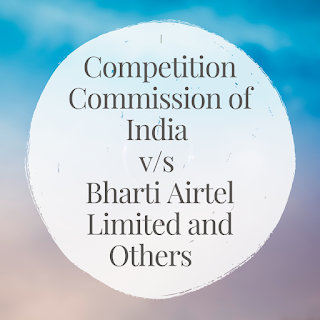CASE
In this case, the Supreme Court resolved the jurisdictional conflict between the CCI and Telecom Regulatory Authority of India and the interplay of roles of the two regulators.
CASE ANALYSIS
The Reliance Jio Infocomm Limited (RJIL) filed an application under Section 19(1) of the Competition Act, 2002, alleging abuse of dominant position and cartelization by Bharti Airtel, Idea Cellular Limited, Vodafone India Limited (the Incumbent Dominant Operator- IDOs) and the Cellular Operators Association of India (COAI) for the infringement of Section-3 and Section-4 of the Act. RJIL alleged that the cartel restricted it to enter into the telecom market by denying the sufficient number of Point of Interconnection (PoI) to it. Further, RJIL filed an application before TRAI to monitor the conduct of IDOs and COAI.
CCI’s order (directing investigation under Section 26(1) of the Act) on the above application was challenged before the Bombay High Court which held that the CCI had no jurisdiction in the matters of telecom sector as in the instant case, the matter was also referred to TRAI which is technically well equipped to deal with the said issue. Aggrieved by the impugned order of the High Court, CCI and RJIL challenged it before the Supreme Court by way of special leave petition.
While concluding the case, the Supreme Court followed the existing jurisprudence of the USA (Credit Suisse & Verizon Communication Case)
STRENGTHS:
- Giving prime autonomy to TRAI as it is a sector specific regulator and has the required expertise to deal with the issues in the telecom sector arising from the Telecom Regulatory Authority of India Act.
- The pronouncement did not debar the CCI completely, but it gave superiority to TRAI over the CCI stating that if there exist evidences to prove the anti-competitive practice, the jurisdiction of the CCI can be enforced as per the Competition Act.
- The Apex Court maintained harmonious construction of relationship between the CCI and TRAI by stating that the authority delegated to the CCI should not be completely washed away. The jurisdiction of the Commission is not completely ousted with regard to telecom sector but the jurisdiction of the CCI is pushed out to later phase, once the issue is decided by the TRAI.
WEAKNESSES:
- The jurisdictional tussle between the CCI and other sector-specific regulatory sectors is pervasive with no proper and standardised solution.
- There is no perfect established medium/provisions which can resolve the jurisdictional issue cooperatively alike in the UK whereby the Office of Fair Trading and regulatory sectors work together to find out the best possible measures.
- If primacy is given to the sector specific regulator over the CCI (to decide on the matters pertaining to anti-competitive practices), then the existence and scope of the CCI would be needless.
- The court ignored the fact that the subject matter of inquiry that was brought before the CCI was entirely different (i.e. formation of cartel and a concerted effort on the part of the service providers, in collusion with COAI, to curb the competition in the market) thus, the CCI was competent and had the requisite jurisdiction to look into this matter. Although, The Bombay Court later held that there was no cartelisation as alleged and COAI was exonerated.
- This judgment defeated the very purpose of Section-60 of the Competition Act.
- The jurisdiction of TRAI ousts the CCI even in the competition related issues.
Author: Riya Gulati
Designation: Paralegal at Law Offices of Caro Kinsella & Youth Ambassador for the ONE Campaign, Ireland.
Qualifications: LL.M (Intellectual Property & Information Technology) from University College Dublin+ BA.LLB from Bharati Vidyapeeth Deemed University.


